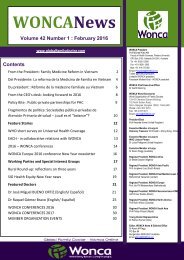You also want an ePaper? Increase the reach of your titles
YUMPU automatically turns print PDFs into web optimized ePapers that Google loves.
SUBSTANCE ABUSEIdentify the patient with substance abuse if 1 or more of:• The misuse of drugs or alcohol causes serious problems for patient, the family and perhaps even the community and/or• > 21 drinks/week (man); > 14 drinks/week (woman); or > 5 drinks/session. 1 drink is 1 tot of spirits, or 1 small glass of wine or 1 can of beer and/or• Yes to 2 or more 1 : Ever felt you should Cut down on drinking? Annoyed if criticized about drinking? Ever felt Guilty about drinking? Ever drink first thing to steady your nerves or treat ahangover? (Eye-opener) and/or• Any use of illicit drugs or misuse of prescription drugs.SUBSTANCE ABUSE: ROUTINE CAREAssess the patient with substance abuseAssessNoteSymptomsRestlessness, confusion, sweating, sleeplessness, hallucinations, agitation, weakness, tremor, headache, nausea - may be withdrawal: refer same day.Harmful useAlcohol: > 35 drinks/week (man); > 20 drinks/week (woman); > 5 drinks/session and/or any use of illicit or prescription drugs can become harmful.DependenceMuch time and energy spent on getting and using substance and withdrawal symptoms above occur on stopping or cutting down.Trauma/abuse If patient reports recent trauma or emotional or sexual abuse 53.Chronic diseaseChronic use of alcohol and/or drugs can have a long term impact on physical health. Assess and manage according to symptoms and chronic disease.Mental illness If low mood or sadness, loss of interest or pleasure, feeling tense or anxious or worrying a lot about things, consider depression/anxiety 81.Advise the patient with substance abuse• Educate patient about effects of substance abuse. Explore patient’s willingness to cut down or stop. Encourage patient to use helpline back page. For communicating effectively see Preface.• Alcohol: Advise abstinence or moderate use (≤ 21 drinks/week (man); ≤ 14 drinks/week (woman) and avoid binges). Advise the pregnant woman to abstain.• Advise patient to stop using illicit or prescription drugs.Dr Doctor to treat the dependant patient with substance abuse• Enrol the dependant patient in a rehabilitation programme starting with detoxification. Ensure patient is motivated to adhere and has the support of a relative/friend.• Admit the patient who refuses help under the Mental Health Care Act only if there is an accompanying mental disorder and patient is causing harm to self or others 80.• For inpatient detoxification if previous withdrawal delirium, fits, psychosis, suicidal, liver disease, failed prior detoxification, no home support, opioid abuse, or if legally committed or detained.• Doctor to provide outpatient detoxification if none of the above inpatient criteria and patient is abusing alcohol, cannabis, mandrax, cocaine, tik or benzodiazepines:SubstanceAlcoholCannabis/Mandrax/Cocaine/TikBenzodiazepinesDetoxification programme• Thiamine 100mg twice a day for 14 days and• Diazepam orally 10mg immediately; then 5mg 6 hourly for 3 days; then 5mg 12 hourly for 2 days; then 5mg daily for 2 days, and then stop. If withdrawal symptoms occur, refer or discuss.• Treatment not always needed. Review after 1 day of abstinence.• Treat anxiety or sleep problems with diazepam 5mg 1–3 times a day tapering over 3–7 days or promethazine 25–50mg orally 8 hourly.• Avoid suddenly stopping benzodiazepines after long-term use.• Replace patient’s benzodiazepine with diazepam. If on lorazepam 0.5mg–1mg give diazepam 5mg (for other benzodiazepines, refer to SAMF or MIC hotline back page).• Adjust diazepam according to symptoms, then decrease diazepam by 2.5mg every 2 weeks. On reaching 20% of initial dose taper by 0.5–2mg/week.1CAGE questions83



